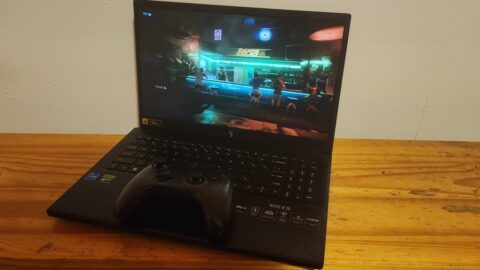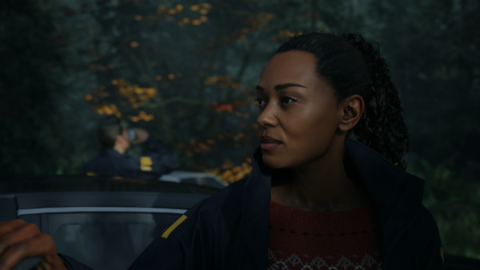As of Dec. 8, gamers can snag a copy of ‘Grand Theft Auto V’ for just $20. And now is a perfect time to play — the trailer for “Grand Theft Auto VI’ just dropped, and the game is coming in 2025.
This is the best cheap gaming laptop of 2023, according to a laptop expert
We tested three cheap gaming laptops this year; this is the best one of 2023.
Acer Nitro 5 review: Is it the best cheap gaming laptop of 2023?
This Acer Nitro 5 review dives into all the pros and cons of this sub-$1,000 laptop.
Viture One review: These XR glasses turn your phone into a 120-inch TV
This Viture One review dives into how it can benefit your everyday life, whether you’re a gamer, a worker bee, a night owl, or a privacy-conscious traveler.

I plugged the Viture One glasses into my brand spankin’ new iPhone 15 Pro Max and my jaw dropped.
There it was. One of my favorite shows – Netflix’s Selling Sunset in all of its glory – hovering before my very eyes on a 120-inch virtual TV via a funky pair of XR glasses.

Credit: Viture
And guess what? Not only can you plug the Viture One into your phone, but you can also connect it to your MacBook and Windows laptop. Hell, you can even stick it into your Steam Deck and Nintendo Switch to enjoy a blown-up gaming experience, which may be particularly useful while traveling.
However, the Viture One XR glasses don’t come cheap.
Viture One XR glasses price and availability
The Viture One XR glasses have an MSRP of $549, but as of this writing, they’re down to $439 on Amazon.
Alongside the XR glasses, you’ll get four nose pads. You can swap ‘em out to test which one feels most comfortable on your honker.

Credit: Viture
You’ll also get a USB-C to magnetic connector cable, which lets you plug your XR glasses into your devices. And finally, a spiffy case ships with the Viture One XR glasses, too, so you can keep ‘em protected while you’re on the go.
I don’t typically talk about packaging in my reviews, but unboxing the Viture One XR glasses was a swanky, premium experience. A couple of “oohs” and “ahhs” escaped my lips while unwrapping the spectacles.
The box opens up like French doors and the quality of the black-and-orange case is top-notch. Even when I tried to deliberately scratch it or leave fingerprints, it was resistant to my attacks.

Credit: Viture
The Viture One XR glasses come in two colors: Jet Black and Matte Indigo.
What I love about the Viture One XR glasses
If you wore the Viture One without the cable attached to it, people would be none the wiser that you’re wearing a pair of badass XR glasses that can maximize your viewing experience into a dazzling 120-inch screen.
Sleek, sophisticated, lightweight design
However upon closer inspection, the Viture One looks bizarrely futuristic. It’s what I’d imagine VR glasses to look like in the year 2050 once we’ve reached Ready Player One nirvana. The top-edge of the glasses – the rims – are thick AF to accommodate two adjustment wheels.

Credit: Kimberly Gedeon / Mashable
These dual dials allow you to adjust the lenses for crystal-clear clarity. I played around with the dials to see if I could enhance the virtual display, but I didn’t need to – the glasses’ out-of-the-box settings were perfect for me.
The glasses’ temples are thick, too, to accommodate the cool tech that facilitates its XR prowess. On the end of the right temple, you’ll find some pogo pins that invite you to magnetically attach its companion cable.
Viture thought ahead about design flaws
While the glasses itself felt lightweight on my face (it’s only 2.7 ounces), the default nose pad felt uncomfortable – as if the weight of spectacles rested on the bridge. Luckily for me, Viture included three other nose pads. I opted for the largest one – it now feels cushy, snug and weightless.

Credit: Viture
I also noticed that, while the glasses were connected to the cable, something kept snagging the wisps of hair that fell around my ears. As it turned out, Viture thought ahead about that, too. The Viture One XR glasses also includes something called an Anti-Clip Hair Cover that surrounds the magnetic pogo pins, which puts an end to all the irksome hair snagging.
Transforms my iPhone 15 Pro Max into a cinematic experience
Apple finally got with the program and added USB-C when it debuted the iPhone 15. This means you no longer need to use an adapter while using any current-generation iPhone (though you will need one for the iPhone 14 and older).

Credit: Kimberly Gedeon / Mashable
I connected the Viture One XR glasses to my iPhone 15 Pro Max, and within seconds, the spectacles mirrored my display. At first, I was concerned – the glasses were mirroring my display in portrait orientation. I thought, “If I launch Netflix right now, will it stay in portrait mode, too?”
Fortunately, that’s not what happened. When I fired up Selling Sunset, the image flipped to horizontal orientation. Before my eyes, I saw reality TV actresses Christelle Stause and Amanza Smith having an emotional conversation on a 120-inch virtual screen, thanks to the micro-OLED screens. The display is 1080p and runs at 60 frames per second.
The show – known for sweeping, drone-facilitated, bird’s eye views of luxurious, million-dollar homes across LA – looked crisp and sharp on the Viture One. It showed off vivid, rich hues of verdant, lush landscaping and textured, colorful roofs.
Viture One worked its magic on my Samsung Galaxy S22 Ultra
I plugged the Viture One into my Samsung Galaxy S22 Ultra, too, but it required a few extra steps to ensure it’d work as smoothly as it did with my iPhone 15 Pro Max. First, while the XR glasses were connected, I had to turn off Samsung DeX, which launched by default. The issue with this feature is that it overrides screen-mirroring mode and splashes an unwanted desktop-like experience to your virtual monitor.

Credit: Kimberly Gedeon / Mashable
You also must go to “Media Output,” which you can find by swiping down from the top of the screen, and switch it to the Viture One – or else you’ll find that the audio will play from the smartphone, not the XR glasses.
With these minor tweaks, I fired up The Wolf of Wall Street and watched Leonardo DiCaprio – clear and crisp as ever — cleverly convince a chump to buy junk stocks.
It supports laptops and tablets, too
I typed this very section using the Viture One with my M2 Pro 14-inch MacBook Pro — and the experience was seamless.

Credit: Kimberly Gedeon / Mashable
Unlike my streaming experience, smudges and other blemishes are less forgiving when it comes to reading text on the Viture One’s virtual monitor. As long as you take a microfiber and clean the lenses, the text on these spectacles are crisp.
What’s the use case for plugging the Viture One XR glasses to your laptop? You can work late nights on it without disturbing your partner. For example, I can darken the screen on my MacBook to its lowest setting, but with the spectacles connected, the virtual monitor is still bright and illuminated, allowing me to navigate on the Viture One without any issues.
This bad boy also works on tablets such as the iPad Air and the Samsung Galaxy Tab S9.
What’s ‘eh’ about the Viture One glasses
There’s a lot to love about the Viture One glasses, but there’s one thing I’m indifferent about: the sound.
The sound is just OK
Viture boasts that that the XR glasses, packed with Harman-tuned audio, deliver an impressive spatial sound experience – and I concur. While watching The Wolf of Wall Street on the Samsung Galaxy S22 Ultra, for example, it felt as if I was sitting in a surround-sound theatre. However, the sound quality is just OK. It’s not remotely terrible, but doesn’t give me an “eargasm” either. However, this is expected because there’s only so much tech you can pack into a tiny pair of XR glasses.
What I don’t like about the Viture One glasses
One of the best use cases for the Viture One is gaming, particularly for those who love to travel with handheld PC consoles like the Steam Deck.

Credit: Kimberly Gedeon / Mashable
Do you know how annoying it is to have to crane your neck over the Steam Deck while you’re on a plane? With the Viture One, you can lay your head comfortably on your reclined seat. No matter where you look, you’ll find the 120-inch display before you while playing your favorite triple-A titles.
I ran Cyberpunk 2077 on my Steam Deck and had a blast picking off enemies one by one while trying to escape goons during a car chase. It’s worth noting that I had to use the adjustment dials to sharpen the display’s clarity, but once I did, I was kicking ass and taking names. I could also see myself using the Viture One for privacy reasons while traveling. Once the smart glasses are connected to the Steam Deck, the screen turns black, so nosybodies can’t see what you’re playing.

Credit: Kimberly Gedeon / Mashable
However, I discovered one small grievance while gaming with my Lenovo Legion 9i.
Viture should offer longer cables
An ideal gaming session with the Viture One XR glasses would allow me to plug ’em into my Legion 9i gaming laptop that sits on my coffee table. After that, I can lie on my back and play my favorite Steam games like Dishonored and Prey – as if I had a 120-inch TV attached to the ceiling. However, I couldn’t fulfill that dream because the cable is too short.
Final thoughts
Keep in mind that the Viture One XR glasses aren’t compatible with every device. For example, when I plugged ’em into the Xiaomi 13T Pro and the Google Pixel 8 Pro, nothing happened. Check the compatibility list to make sure the Viture One XR glasses support your device of choice.
The Viture One is my favorite tech device I’ve tested this year. It has so many use cases, from transforming your smartphone into a 120-inch TV experience to upgrading your comfort while traveling with your Steam Deck. The only thing I’d change about it is the short cable, but other than that, these XR glasses are totally worth the $500 price tag.

Opens in a new window
‘Alan Wake II’ review: A horror masterpiece
A review of Remedy Entertainment’s ‘Alan Wake II’ for PS5, Xbox, and PC.

There is nothing out there quite like Remedy Entertainment’s Alan Wake II. A tense, slow, and acid-induced horror journey through the eyes of its main protagonists, Alan Wake and Saga Anderson, Alan Wake II sits at the very pinnacle of the survival horror genre.
If that sounds like high praise, well, it is, because it’s a damn good game. Building upon not just its predecessor, Alan Wake, but on everything within the Remedy catalog — taking the old and creating a wholly unique gaming experience, unlike anything its contemporaries in the genre offer.
Alan Wake II launched on Oct. 27, and from the 14 hours I played — about 70 percent of the game — I was very impressed. In a month stacked with heavy hitters such as Marvel’s Spider-Man 2 and Super Mario Bros. Wonder, Alan Wake II is a stand-out that kept me hooked.
Crab MLMs, gay Dracula, and Pooh Bear body horror: 9 of the best upcoming games at SXSW Sydney
You will never feel safe

Credit: Remedy Entertainment/Epic Games
Alan Wake II‘s inspirations reach across all genres and mediums, creating a game that both feels familiar and unique at the same time. From its Twin Peaks-inspired town to its grungy, dirty crime noir nightmare version of New York City, the games’ two worlds offer players a feast for the eyes.
The game, set 13 years after its predecessor, sees FBI Agent Saga Anderson travel to the fictional town of Bright Falls, Washington, to investigate several disappearances and murders that have taken place in town. Meanwhile, the titular Alan Wake tries to write himself out of the Dark Place — a surreal alternate reality outside space and time that can turn art into reality — which sits at the bottom of Bright Falls’ Cauldron Lake.
Players can at any time switch between the two protagonists, its two worlds offering a distinctive style and tone. The two areas are small, dense, and technical marvels to enjoy. As Saga, players are introduced to a methodical, investigatory slow-burn detective story, while Wake is trapped in a filthy art-deco neo-noir meets horror movie mashup. And it’s a clear choice by Remedy to make its story a slow, plodding build so as to invest players in its characters and mystery.
Essential to this detective story is the game’s central mechanic, the Plot Board, which Saga can access from her Mind Place — a sort of quasi-pause menu where players can piece together deductions made from their investigations of the main quest and the various side quests found around town and other areas. It’s a unique way of keeping track of character progression but also doesn’t require the player to use it in order to figure out how to progress the plot. This allows players to piece together the case themselves without the game holding their hands as they explore the surroundings on offer.
And that’s a good thing because this game demands the player’s attention as they slowly walk through the beautiful town of Bright Falls and the surrounding areas of Watery and Cauldron Lake. Set in the Pacific Northwest, trekking through these areas as Saga is a treat as the environments feel natural and authentic, with Remedy playing into its strength with compelling environmental storytelling. Wading through the woods outside of town as your investigation furthers, the sound design and level of detail make sure you never feel safe. There is always a sense of foreboding doom the minute you leave your safe havens, and it makes for a tense journey as you progress through the game.

Credit: Remedy Entertainment/Epic Games
The stark contrast to the greenery and stunning views of Bright Falls is Alan Wake’s nightmare version of New York City. An unnatural, grimy place, this version of New York feels like being trapped in an art museum after hours. Each building was placed with careful consideration, as if the city was put on display for the mind of its imprisoned inhabitant. The area is detailed and dense, with everything from the street clutter to the graffiti on the wall having some message behind it. The ambiance of the city is filled with broken street lamps and dingy neon lights that guide Alan toward his next objective. Compared to the strange eeriness of Bright Falls, the world of Nightmare New York is more hard-boiled, its city inspired by right-wing vigilante fantasies like Death Wish and its ilk.
The world design, by far, is the best part of Alan Wake II. It’s small and intimate, and it tells a hundred stories before a word is even said. It’s atmospheric in a way that not even a lot of immersive sims are, and it allows Remedy to do some truly bizarre and meta things within the chosen genres and motifs of its world.
It’s hunting season

Credit: Remedy Entertainment/Epic Games
I spent a lot of time gushing about the world of Alan Wake II, but how’s the gameplay? It’s fine. If you’ve played any of the Resident Evil remakes, you’ve played Alan Wake II. Not to say the gameplay is bad–it’s quite solid, actually—but it’s clear that combat was not what Remedy was focused on here.
The shooting is good, with each gun having a decent weight to it when fired. The core gameplay loop doesn’t get tiring, with your character shining their light on enemies to get rid of their darkness shield before blasting away at them. This is complemented by an excellent sound design that makes for an auditory treat whenever you shoot enemies’ weak spots. However, the options of weapons are quite limited for both characters, and the enemy variety is sparse. There are 3-4 different variants of “Taken,” there’s the big variant, the melee variants, and the ranged variants. While the game says that there are different ways to approach each of these, in my experience in the game, this is very inconsistent, and most of the enemies tend to be bullet sponges.
The bosses are particular high points. While the bosses are still of the point-and-shoot variety, they do offer compelling visual and thematic areas not found in the game as players enter “Overlaps” between the real world and the Dark Place. With the way combat is designed, Remedy understood that too much can be a bad thing, and you’ll rarely ever engage in combat and seldom, if ever, face more than one or two enemies at a time.
Alan’s side of the game is a little tenser and less combat-focused. Instead of running into bog-standard enemies, Nightmare New York is littered with shadowed silhouettes that may or may not try to engage you. The game forces you to get up close and personal with them as they whisper and shout your name. Some shadows may grab you while others will full-on attack you, with Alan never knowing which is which until it’s too late. This makes for tense encounters as you progress through the plot, and it’s clear that Remedy is more focused on building a sense of dread as the player rummages through the world than just becoming another action-horror shooter. It’s a massive improvement compared to its predecessor, Alan Wake, with its floaty combat mechanics and stilted graphics making it the quintessential 2010s bargain bin action-horror title.

Credit: Remedy Entertainment/Epic Games
The bottom line

Credit: Remedy Entertainment/Epic Games
Often with these kinds of games, the story is secondary to the combat, but Alan Wake II takes a different approach, building upon its connected universe without getting too in the player’s face. In each of the games, Remedy has sought to combine gameplay with narrative. Alan Wake’s story within the story told you how everything would play out, Max Payne was heavy on reactive internal monologues, and Control was a lore-rich narrative that rewarded players for exploration. All these combined create what is essentially a magnum opus for Remedy, with Alan Wake II being the culmination of a decade’s worth of experience and game design. That’s without talking about its performance, which runs almost perfectly, bar the rare visual glitch.
With the review for this game, which was possible thanks to a review code from Remedy and Epic Games, I didn’t want to talk about the story too much beyond the bare-bones plot. That’s because it has to be experienced first, and anything I can say about it will undersell just how impressive it is. Video games have never been a bastion of good writing, except in rare cases, and that just comes with the territory. But Alan Wake II is a story that needs to be replayed a couple of times — it’s a unique blend of meta-commentary, live-action, and incorporation of music that creates a story that can’t be told in other any format, medium, or genre — and it needs more than one playthrough to truly, fully understand and appreciate it. Alan Wake II touches upon and references Remedy’s other games, but does so in a way that feels familiar to fans of these games while also allowing new players to feel welcomed into the world.
In an industry littered with unfinished, high-budget triple-A video games, it is refreshing to see a near-perfect and polished game released on day one. Remedy’s Alan Wake II is not only the studio’s best game to date, but it’s one of the best games of its genre and perhaps of the year.
Triple-A gets funding from Peak XV to help more businesses use crypto
Created by the founder of Thunes, global digital currency payments institution Triple-A wants to close the gap between traditional finance and blockchain-based payments with its white-label solutions for […]







